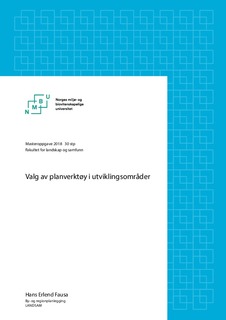| dc.contributor.advisor | Børrud, Elin | |
| dc.contributor.author | Fausa, Hans Erlend | |
| dc.coverage.spatial | Norway, Oslo | nb_NO |
| dc.date.accessioned | 2018-08-14T09:03:44Z | |
| dc.date.available | 2018-08-14T09:03:44Z | |
| dc.date.issued | 2018 | |
| dc.identifier.uri | http://hdl.handle.net/11250/2557840 | |
| dc.description.abstract | Masteroppgaven undersøker Oslo kommunes bruk av områderegulering og veiledende planer for offentlige rom (VPOR). Kommunen ønsker å bruke plantypene som retningslinjer og styring i prioriterte områder for utvikling og en høyere arealutnyttelse. Oppgaven bruker Oslo kommune som caseområde med delområdene Breivoll, Bryn, Hasle, Lysaker, Filipstad, Skøyen og Furuset, for å undersøke hvilke planbehov som foreligger i områdene og hvilke vilkår som ligger til grunn for valg av plantype.
Basert på oppgavens teoretiske rammeverk vurderer jeg områdereregulering som en regulativ prosjektplan og VPOR som et strategisk rammeverk. Studien viser at områderegulering og VPOR brukes både for prosjektering og for strategiske grep, og det er ofte vanskelig å skille de fra hverandre i bruk og forståelse. De faktorene jeg ser som har størst innflytelse på valg av planverktøy i fortetting og knutepunktsområder:
• Grunneierforhold og fysisk struktur
• Tidshorisont
• Politisk bilde
Grunneierforhold og de fysiske strukturene viser til koordinering, redegjørelse av ansvarsforhold og hva som kreves for å endre et område. Neste steg blir å vurdere hvilket tidsperspektiv som foreligger. Har området en kort tidshorisont krever det en regulativ prosjektplan til tross for at området har en høy kompleksitet og behov for strategiske grep. Det politiske bildet viser til hvilken politisk farge som styrer og hvordan politikere og byrådet ønsker å bruke planene som styringsverktøy. Utfordringen med kriteriene er at de spiller inn i ulik grad i de ulike områdene. Dette betyr at valg av planene ikke bare gjøres ut fra områdenes behov, men krever flere lag med avveininger basert på politiske ønsker, befolkningen og utbyggere som ønsker å realisere prosjekter i områdene. Basert på det teoretiske rammeverket og funnene i oppgaven går jeg videre for å diskutere forståelse av planene og hvilke hensikter som ligger bak bruken. Jeg foreslår da en differensiering av plantypene, og hvordan de plasserer seg inn i planhierarkiet for å skape legitime og forutsigbare planprosesser. | nb_NO |
| dc.description.abstract | The Master thesis examines Oslo municipality's use of area zoning plans and guidance plans for public spaces (VPOR). The municipality wishes to use the plans as guidelines and management in priority areas for development and densification. The thesis will use Oslo municipality as a case area, with Breivoll, Bryn, Hasle, Lysaker, Filipstad, Skoyen and Furuset as subdivisions to investigate the planning needs in the area and the conditions underlying the choice of plan.
Based on the theoretical framework, I consider area zoning plan as a regulatory project plan and VPOR as a strategic framework. The study shows that area zoning plans and VPOR are both used for project and strategic purposes, and it is often difficult to distinguish them in use and understanding. The factors I see that have the greatest influence on the choice of planning tools are:
• Landownership and physical structure
• Time horizon
• Political landscape
Landowners and physical structures refer to coordination, accountability and what is required to change an area. The next step will be to assess what time perspective is available. If the area has a short time horizon, it requires a regulatory project plan, despite the fact that the area has a high complexity and need for strategic measures. The political picture shows what political colour governs and how politicians and city councils want to use the plans as a management tool. Challenges with the criteria is the difference in meaning in different areas. This means that
the choice of plans is not only based on the needs of the areas, but also requires many trade-offs based on political wishes, the population and the builders who want to realize projects in the areas.
Based on the theoretical framework and the findings in the assignment, I proceed to discuss the understanding of the plans and the purposes behind them. I propose a differentiation of the plans and how they place themselves in the planning hierarchy, to create legitimate and predictable planning processes. Thus, plans can better cope with policy changes and different challenges and needs that exist in areas that are above the short and long-term development. | nb_NO |
| dc.description.sponsorship | Norsk Institutt for By- og Regionforskning (NIBR) | nb_NO |
| dc.language.iso | nob | nb_NO |
| dc.publisher | Norwegian University of Life Sciences, Ås | nb_NO |
| dc.rights | Attribution-NonCommercial-NoDerivatives 4.0 Internasjonal | * |
| dc.rights.uri | http://creativecommons.org/licenses/by-nc-nd/4.0/deed.no | * |
| dc.title | Valg av planverktøy i utviklingsområder : hvilke vilkår ligger til grunn for Oslo kommunes valg av prosjekt og strategiske planverktøy? Og hvordan kan forutsigbarhet og legitimitet sikres i planprosessene for områder som står ovenfor store endringer? | nb_NO |
| dc.type | Master thesis | nb_NO |
| dc.description.version | submittedVersion | nb_NO |
| dc.subject.nsi | By- og regionplanlegging | nb_NO |
| dc.description.localcode | M-BYREG | nb_NO |

